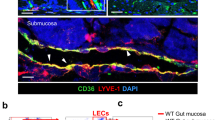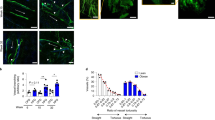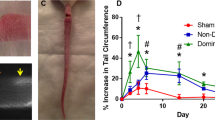Abstract
Multiple organs cooperate to regulate appetite, metabolism, and glucose and fatty acid homeostasis. Here, we identified and characterized lymphatic vasculature dysfunction as a cause of adult-onset obesity. We found that functional inactivation of a single allele of the homeobox gene Prox1 led to adult-onset obesity due to abnormal lymph leakage from mispatterned and ruptured lymphatic vessels. Prox1 heterozygous mice are a new model for adult-onset obesity and lymphatic vascular disease.
This is a preview of subscription content, access via your institution
Access options
Subscribe to this journal
Receive 12 print issues and online access
$209.00 per year
only $17.42 per issue
Buy this article
- Purchase on Springer Link
- Instant access to full article PDF
Prices may be subject to local taxes which are calculated during checkout








Similar content being viewed by others
References
Wigle, J.T., Chowdhury, K., Gruss, P. & Oliver, G. Prox1 function is crucial for mouse lens-fibre elongation. Nat. Genet. 21, 318–322 (1999).
Wigle, J.T. & Oliver, G. Prox1 function is required for the development of the murine lymphatic system. Cell 98, 769–778 (1999).
Sosa-Pineda, B., Wigle, J.T. & Oliver, G. Hepatocyte migration during liver development requires Prox1. Nat. Genet. 25, 254–255 (2000).
Burke, Z. & Oliver, G. Prox1 is an early specific marker for the developing liver and pancreas in the mammalian foregut endoderm. Mech. Dev. 118, 147–155 (2002).
Dyer, M.A., Livesey, F.J., Cepko, C.L. & Oliver, G. Prox1 function controls progenitor cell proliferation and horizontal cell genesis in the mammalian retina. Nat. Genet. 34, 53–58 (2003).
Wigle, J.T. et al. An essential role for Prox1 in the induction of the lymphatic endothelial cell phenotype. EMBO J. 21, 1505–1513 (2002).
Flier, J.S. Obesity wars: molecular progress confronts an expanding epidemic. Cell 116, 337–350 (2004).
Schwartz, M.W. & Porte, D. Jr. Diabetes, obesity, and the brain. Science 307, 375–379 (2005).
Zhang, Y. et al. Positional cloning of the mouse obese gene and its human homologue. Nature 372, 425–432 (1994).
Browning, J.D. & Horton, J.D. Molecular mediators of hepatic steatosis and liver injury. J. Clin. Invest. 114, 147–152 (2004).
Angulo, P. Nonalcoholic fatty liver disease. N. Engl. J. Med. 346, 1221–1231 (2002).
Ho, M.K. & Springer, T.A. Mac-2, a novel 32,000 Mr mouse macrophage subpopulation-specific antigen defined by monoclonal antibodies. J. Immunol. 128, 1221–1228 (1982).
Xu, H. et al. Chronic inflammation in fat plays a crucial role in the development of obesity-related insulin resistance. J. Clin. Invest. 112, 1821–1830 (2003).
Weisberg, S.P. et al. Obesity is associated with macrophage accumulation in adipose tissue. J. Clin. Invest. 112, 1796–1808 (2003).
Esther, C.R. Jr. & Barker, P.M. Pulmonary lymphangiectasia: diagnosis and clinical course. Pediatr. Pulmonol. 38, 308–313 (2004).
Brorson, H. Liposuction in arm lymphedema treatment. Scand. J. Surg. 92, 287–295 (2003).
Karkkainen, M.J. et al. A model for gene therapy of human hereditary lymphedema. Proc. Natl. Acad. Sci. USA 98, 12677–12682 (2001).
Banerji, S. et al. LYVE-1, a new homologue of the CD44 glycoprotein, is a lymph-specific receptor for hyaluronan. J. Cell Biol. 144, 789–801 (1999).
Rosen, E.D. The molecular control of adipogenesis, with special reference to lymphatic pathology. Ann. NY Acad. Sci. 979, 143–158 (2002).
Nougues, J., Reyne, Y. & Dulor, J.P. Differentiation of rabbit adipocyte precursors in primary culture. Int. J. Obes. 12, 321–333 (1988).
MacDougald, O.A. & Lane, M.D. Transcriptional regulation of gene expression during adipocyte differentiation. Annu. Rev. Biochem. 64, 345–373 (1995).
Kisanuki, Y.Y. et al. Tie2-Cre transgenic mice: a new model for endothelial cell-lineage analysis in vivo . Dev. Biol. 230, 230–242 (2001).
Schnurch, H. & Risau, W. Expression of tie-2, a member of a novel family of receptor tyrosine kinases, in the endothelial cell lineage. Development 119, 957–968 (1993).
Sato, T.N., Qin, Y., Kozak, C.A. & Audus, K.L. Tie-1 and tie-2 define another class of putative receptor tyrosine kinase genes expressed in early embryonic vascular system. Proc. Natl. Acad. Sci. USA 90, 9355–9358 (1993).
Pond, C.M. & Mattacks, C.A. Interactions between adipose tissue around lymph nodes and lymphoid cells in vitro . J. Lipid Res. 36, 2219–2231 (1995).
Pond, C.M. & Mattacks, C.A. The source of fatty acids incorporated into proliferating lymphoid cells in immune-stimulated lymph nodes. Br. J. Nutr. 89, 375–383 (2003).
Pond, C.M. Paracrine relationships between adipose and lymphoid tissues: implications for the mechanism of HIV-associated adipose redistribution syndrome. Trends Immunol. 24, 13–18 (2003).
Mattacks, C.A., Sadler, D. & Pond, C.M. The cellular structure and lipid/protein composition of adipose tissue surrounding chronically stimulated lymph nodes in rats. J. Anat. 202, 551–561 (2003).
Schacht, V. et al. T1alpha/podoplanin deficiency disrupts normal lymphatic vasculature formation and causes lymphedema. EMBO J. 22, 3546–3556 (2003).
Yuan, L. et al. Abnormal lymphatic vessel development in neuropilin 2 mutant mice. Development 129, 4797–4806 (2002).
Gale, N.W. et al. Angiopoietin-2 is required for postnatal angiogenesis and lymphatic patterning, and only the latter role is rescued by Angiopoietin-1. Dev. Cell 3, 411–423 (2002).
Di Girolamo, M., Mendlinger, S. & Fertig, J.W. A simple method to determine fat cell size and number in four mammalian species. Am. J. Physiol. 221, 850–858 (1971).
Jandacek, R.J., Heubi, J.E. & Tso, P. A novel, non-invasive method for the measurement of intestinal fat absorption. Gastroenterology 127, 139–144 (2004).
Acknowledgements
We thank N. Gale for the LYVE-1 antibody and for discussions; M. Kahn for advice regarding the BODIPY FL C16 assay; M. Yanagisawa for the Tie2-Cre mice; R. Jandacek and P. Tso for the fatty acid absorption assay; M. Self for technical assistance; Y. Lee, A. Lavado and T. Nastasi for help with tissue dissections; M. Straign for the blood chemistry analysis; L. Mann and G. Murti for electron microscopy; G. Neale for help with microarray analysis; A. McArthur for editing the manuscript; B. Sosa-Pineda for discussions and critical reading of the manuscript; and D. Wasserman and G. Grosveld for discussions. This work was supported in part by a grant from the US National Institutes of Health to G.O., a Cancer Center Support Grant and the American Lebanese Syrian Associated Charities.
Author information
Authors and Affiliations
Corresponding author
Ethics declarations
Competing interests
The authors declare no competing financial interests.
Supplementary information
Supplementary Fig. 1
Expression of POMC, NPY, and CART is unaltered in the hypothalamus of adult Prox1+/− mice. (PDF 617 kb)
Supplementary Fig. 2
Metabolic features of Prox1-heterozygous mice and their wild-type counterparts. (PDF 241 kb)
Supplementary Fig. 3
Microarray analysis of muscle and adipose tissue from adult Prox1+/− and wild-type mice. (PDF 145 kb)
Supplementary Fig. 4
Prox1+/− mice exhibit alterations in directional lymph flow. (PDF 1692 kb)
Supplementary Fig. 5
Scheme of the Prox1 conditional knock-out construct. (PDF 129 kb)
Supplementary Table 1
Primer sequences used for RT-PCR amplification of the genes indicated from 3T3-L1 cells. (PDF 94 kb)
Rights and permissions
About this article
Cite this article
Harvey, N., Srinivasan, R., Dillard, M. et al. Lymphatic vascular defects promoted by Prox1 haploinsufficiency cause adult-onset obesity. Nat Genet 37, 1072–1081 (2005). https://doi.org/10.1038/ng1642
Received:
Accepted:
Published:
Issue Date:
DOI: https://doi.org/10.1038/ng1642
This article is cited by
-
Lymphatic vessel: origin, heterogeneity, biological functions, and therapeutic targets
Signal Transduction and Targeted Therapy (2024)
-
A Prox1 enhancer represses haematopoiesis in the lymphatic vasculature
Nature (2023)
-
Biomechanical control of lymphatic vessel physiology and functions
Cellular & Molecular Immunology (2023)
-
Fibroblastic reticular cells in lymph node potentiate white adipose tissue beiging through neuro-immune crosstalk in male mice
Nature Communications (2023)
-
Molecular and metabolic orchestration of the lymphatic vasculature in physiology and pathology
Nature Communications (2023)



